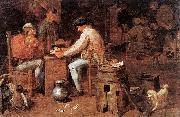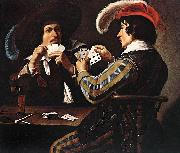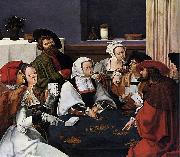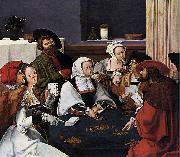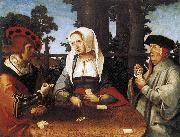Wholesale Oil Painting No Minimum |
|||||||||||
|
|
|||||||||||

|
|||||||||||
|
|
|
||||||||
Lucas van Leyden1489-1533 Dutch Lucas van Leyden Galleries Lucas van Leyden (Leiden, 1494 ?C August 8, 1533 in Leiden), also named either Lucas Hugensz or Lucas Jacobsz, was a Dutch engraver and painter, born and mainly active in Leiden, who was among the first Dutch exponents of genre painting and is generally regarded as one of the finest engravers in the history of art. He was the pupil of his father, from whose hand no works are known, and of Cornelis Engelbrechtsz, but both of these were painters whereas Lucas himself was principally an engraver. Where he learnt engraving is unknown, but he was highly skilled in that art at a very early age: the earliest known print by him (Mohammed and the Murdered Monk) dates from 1508, when he was perhaps only 14, yet reveals no trace of immaturity in inspiration or technique. Lot and his daughters (ca. 1509)In 1514 he entered the Painters' Guild at Leiden. He seems to have travelled a certain amount, and visits are recorded to Antwerp in 1521, the year of D??rer's Netherlandish journey, and to Middelburg in 1527, when he met Jan Mabuse. An unbroken series of dated engravings makes it possible to follow his career as a print-maker and to date many of his paintings, but no clear pattern of stylistic development emerges. D??rer was the single greatest influence on him, but Lucas was less intellectual in his approach, tending to concentrate on the anecdotal features of the subject and to take delight in caricatures and genre motifs. Carel van Mander characterizes Lucas as a pleasure-loving dilettante, who sometimes worked in bed, but he left a large oeuvre, in spite of his fairly early death, and must have been a prodigious worker. Lucas had a great reputation in his day (Vasari even rated him above D??rer) and is universally regarded as one of the greatest figures in the history of graphic art (he made etchings and woodcuts as well as engravings and was a prolific draughtsman). His status as a painter is less elevated, but he was undoubtedly one of the outstanding Netherlandish painters of his period. He was a pioneer of the Netherlandish genre tradition, as witness his Chess Players (Gemäldegalerie, Berlin) which actually represents a variant game called 'courier' - and his Card Players (National Gallery of Art, Washington), while his celebrated Last Judgement triptych (Lakenhal Museum, Leiden, 1526-27) shows the heights to which he could rise as a religious painter. It eloquently displays his vivid imaginative powers, his marvellous skill as a colourist and his deft and fluid brushwork. |
||||||||
|
|
||||||||
Card Players
Card Players Painting ID:: 2449 |
National Gallery of Art, Washington DC National Gallery of Art, Washington DC |
|||||||
|
|
||||||||
BROUWER, AdriaenFlemish Baroque Era Painter, ca.1605-1638 Adriaen Brouwer (1605, Oudenaarde - January 1638, Antwerp) was a Flemish genre painter active in Flanders and the Dutch Republic in the seventeenth century. At a young age Brouwer, probably born as Adriaen de Brauwer, moved perhaps via Antwerp to Haarlem, where he became a student of Frans Hals alongside Adriaen van Ostade. He also was active in stage acting and poetry. He stayed in Haarlem and Amsterdam until 1631, when he moved back to Antwerp in the Spanish Netherlands. There, he became a member of the Guild of St. Luke in 1631 ?C 1632, as well as the rhetoricians's chamber De Violieren. Tradition has it that Brouwer himself spent much time in the alehouses of Flanders and Holland. His works are typically detailed and small, and often adopt themes of debauchery, drunkenness and foolishness in order to explore human emotions, expressions and responses to pain, fear and the senses. The Bitter Tonic (illustrated right) is an example of the type of work that depicts such responses, in this case the sense of taste. His work was well liked, to the point that forgeries were sold in his own time. Both Rubens and Rembrandt owned a number of his works. Nevertheless, Brouwer appeared in financial trouble throughout his life. He died at the early age of 32 in Antwerp, where he was first buried in a common grave, but, upon instigation of the members of the guild, was reburied on Feb 1, 1638 in the church of the Carmelites. |
||||||||
|
|
||||||||
|
|
Card Players
Card Players Painting ID:: 73761 |
Medium oil on wood
Dimensions 25 X 39 cm (9.84 X 15.35 in)
cyf Medium oil on wood Dimensions 25 X 39 cm (9.84 X 15.35 in) cyf |
||||||
|
|
||||||||
Theodoor RomboutsFlemish , b. 1597, Antwerpen, d. 1637, Antwerpen was a Flemish Baroque painter specializing in Caravaggesque genre scenes of card players and musicians. He studied under Abraham Janssens in Antwerp and was in Italy between 1616 and 1625, where he was heavily influenced by Caravaggio. |
||||||||
|
|
||||||||
|
|
Card Players
Card Players Painting ID:: 74319 |
Date 17th century
Medium Oil on canvas
cyf Date 17th century Medium Oil on canvas cyf |
||||||
|
|
||||||||
Lucas van Leyden1489-1533 Dutch Lucas van Leyden Galleries Lucas van Leyden (Leiden, 1494 ?C August 8, 1533 in Leiden), also named either Lucas Hugensz or Lucas Jacobsz, was a Dutch engraver and painter, born and mainly active in Leiden, who was among the first Dutch exponents of genre painting and is generally regarded as one of the finest engravers in the history of art. He was the pupil of his father, from whose hand no works are known, and of Cornelis Engelbrechtsz, but both of these were painters whereas Lucas himself was principally an engraver. Where he learnt engraving is unknown, but he was highly skilled in that art at a very early age: the earliest known print by him (Mohammed and the Murdered Monk) dates from 1508, when he was perhaps only 14, yet reveals no trace of immaturity in inspiration or technique. Lot and his daughters (ca. 1509)In 1514 he entered the Painters' Guild at Leiden. He seems to have travelled a certain amount, and visits are recorded to Antwerp in 1521, the year of D??rer's Netherlandish journey, and to Middelburg in 1527, when he met Jan Mabuse. An unbroken series of dated engravings makes it possible to follow his career as a print-maker and to date many of his paintings, but no clear pattern of stylistic development emerges. D??rer was the single greatest influence on him, but Lucas was less intellectual in his approach, tending to concentrate on the anecdotal features of the subject and to take delight in caricatures and genre motifs. Carel van Mander characterizes Lucas as a pleasure-loving dilettante, who sometimes worked in bed, but he left a large oeuvre, in spite of his fairly early death, and must have been a prodigious worker. Lucas had a great reputation in his day (Vasari even rated him above D??rer) and is universally regarded as one of the greatest figures in the history of graphic art (he made etchings and woodcuts as well as engravings and was a prolific draughtsman). His status as a painter is less elevated, but he was undoubtedly one of the outstanding Netherlandish painters of his period. He was a pioneer of the Netherlandish genre tradition, as witness his Chess Players (Gemäldegalerie, Berlin) which actually represents a variant game called 'courier' - and his Card Players (National Gallery of Art, Washington), while his celebrated Last Judgement triptych (Lakenhal Museum, Leiden, 1526-27) shows the heights to which he could rise as a religious painter. It eloquently displays his vivid imaginative powers, his marvellous skill as a colourist and his deft and fluid brushwork. |
||||||||
|
|
||||||||
|
|
Card Players
Card Players Painting ID:: 85236 |
between 1508(1508) and 1510(1510)
Medium Oil on panel
cyf between 1508(1508) and 1510(1510) Medium Oil on panel cyf |
||||||
|
|
||||||||
Lucas van Leyden1489-1533 Dutch Lucas van Leyden Galleries Lucas van Leyden (Leiden, 1494 ?C August 8, 1533 in Leiden), also named either Lucas Hugensz or Lucas Jacobsz, was a Dutch engraver and painter, born and mainly active in Leiden, who was among the first Dutch exponents of genre painting and is generally regarded as one of the finest engravers in the history of art. He was the pupil of his father, from whose hand no works are known, and of Cornelis Engelbrechtsz, but both of these were painters whereas Lucas himself was principally an engraver. Where he learnt engraving is unknown, but he was highly skilled in that art at a very early age: the earliest known print by him (Mohammed and the Murdered Monk) dates from 1508, when he was perhaps only 14, yet reveals no trace of immaturity in inspiration or technique. Lot and his daughters (ca. 1509)In 1514 he entered the Painters' Guild at Leiden. He seems to have travelled a certain amount, and visits are recorded to Antwerp in 1521, the year of D??rer's Netherlandish journey, and to Middelburg in 1527, when he met Jan Mabuse. An unbroken series of dated engravings makes it possible to follow his career as a print-maker and to date many of his paintings, but no clear pattern of stylistic development emerges. D??rer was the single greatest influence on him, but Lucas was less intellectual in his approach, tending to concentrate on the anecdotal features of the subject and to take delight in caricatures and genre motifs. Carel van Mander characterizes Lucas as a pleasure-loving dilettante, who sometimes worked in bed, but he left a large oeuvre, in spite of his fairly early death, and must have been a prodigious worker. Lucas had a great reputation in his day (Vasari even rated him above D??rer) and is universally regarded as one of the greatest figures in the history of graphic art (he made etchings and woodcuts as well as engravings and was a prolific draughtsman). His status as a painter is less elevated, but he was undoubtedly one of the outstanding Netherlandish painters of his period. He was a pioneer of the Netherlandish genre tradition, as witness his Chess Players (Gemäldegalerie, Berlin) which actually represents a variant game called 'courier' - and his Card Players (National Gallery of Art, Washington), while his celebrated Last Judgement triptych (Lakenhal Museum, Leiden, 1526-27) shows the heights to which he could rise as a religious painter. It eloquently displays his vivid imaginative powers, his marvellous skill as a colourist and his deft and fluid brushwork. |
||||||||
|
|
||||||||
|
|
Card Players
Card Players Painting ID:: 90315 |
Oil on panel, 56 x 70 cm, National Gallery of Art, Washington
Date 1508 - 10
cyf Oil on panel, 56 x 70 cm, National Gallery of Art, Washington Date 1508 - 10 cyf |
||||||
|
|
||||||||
Lucas van Leyden1489-1533 Dutch Lucas van Leyden Galleries Lucas van Leyden (Leiden, 1494 ?C August 8, 1533 in Leiden), also named either Lucas Hugensz or Lucas Jacobsz, was a Dutch engraver and painter, born and mainly active in Leiden, who was among the first Dutch exponents of genre painting and is generally regarded as one of the finest engravers in the history of art. He was the pupil of his father, from whose hand no works are known, and of Cornelis Engelbrechtsz, but both of these were painters whereas Lucas himself was principally an engraver. Where he learnt engraving is unknown, but he was highly skilled in that art at a very early age: the earliest known print by him (Mohammed and the Murdered Monk) dates from 1508, when he was perhaps only 14, yet reveals no trace of immaturity in inspiration or technique. Lot and his daughters (ca. 1509)In 1514 he entered the Painters' Guild at Leiden. He seems to have travelled a certain amount, and visits are recorded to Antwerp in 1521, the year of D??rer's Netherlandish journey, and to Middelburg in 1527, when he met Jan Mabuse. An unbroken series of dated engravings makes it possible to follow his career as a print-maker and to date many of his paintings, but no clear pattern of stylistic development emerges. D??rer was the single greatest influence on him, but Lucas was less intellectual in his approach, tending to concentrate on the anecdotal features of the subject and to take delight in caricatures and genre motifs. Carel van Mander characterizes Lucas as a pleasure-loving dilettante, who sometimes worked in bed, but he left a large oeuvre, in spite of his fairly early death, and must have been a prodigious worker. Lucas had a great reputation in his day (Vasari even rated him above D??rer) and is universally regarded as one of the greatest figures in the history of graphic art (he made etchings and woodcuts as well as engravings and was a prolific draughtsman). His status as a painter is less elevated, but he was undoubtedly one of the outstanding Netherlandish painters of his period. He was a pioneer of the Netherlandish genre tradition, as witness his Chess Players (Gemäldegalerie, Berlin) which actually represents a variant game called 'courier' - and his Card Players (National Gallery of Art, Washington), while his celebrated Last Judgement triptych (Lakenhal Museum, Leiden, 1526-27) shows the heights to which he could rise as a religious painter. It eloquently displays his vivid imaginative powers, his marvellous skill as a colourist and his deft and fluid brushwork. |
||||||||
|
|
||||||||
|
|
Card Players
Card Players Painting ID:: 96276 |
1525(1525)
Medium oil on panel
cyf 1525(1525) Medium oil on panel cyf |
||||||
|
|
||||||||
|
Lucas van Leyden 1489-1533 Dutch Lucas van Leyden Galleries Lucas van Leyden (Leiden, 1494 ?C August 8, 1533 in Leiden), also named either Lucas Hugensz or Lucas Jacobsz, was a Dutch engraver and painter, born and mainly active in Leiden, who was among the first Dutch exponents of genre painting and is generally regarded as one of the finest engravers in the history of art. He was the pupil of his father, from whose hand no works are known, and of Cornelis Engelbrechtsz, but both of these were painters whereas Lucas himself was principally an engraver. Where he learnt engraving is unknown, but he was highly skilled in that art at a very early age: the earliest known print by him (Mohammed and the Murdered Monk) dates from 1508, when he was perhaps only 14, yet reveals no trace of immaturity in inspiration or technique. Lot and his daughters (ca. 1509)In 1514 he entered the Painters' Guild at Leiden. He seems to have travelled a certain amount, and visits are recorded to Antwerp in 1521, the year of D??rer's Netherlandish journey, and to Middelburg in 1527, when he met Jan Mabuse. An unbroken series of dated engravings makes it possible to follow his career as a print-maker and to date many of his paintings, but no clear pattern of stylistic development emerges. D??rer was the single greatest influence on him, but Lucas was less intellectual in his approach, tending to concentrate on the anecdotal features of the subject and to take delight in caricatures and genre motifs. Carel van Mander characterizes Lucas as a pleasure-loving dilettante, who sometimes worked in bed, but he left a large oeuvre, in spite of his fairly early death, and must have been a prodigious worker. Lucas had a great reputation in his day (Vasari even rated him above D??rer) and is universally regarded as one of the greatest figures in the history of graphic art (he made etchings and woodcuts as well as engravings and was a prolific draughtsman). His status as a painter is less elevated, but he was undoubtedly one of the outstanding Netherlandish painters of his period. He was a pioneer of the Netherlandish genre tradition, as witness his Chess Players (Gemäldegalerie, Berlin) which actually represents a variant game called 'courier' - and his Card Players (National Gallery of Art, Washington), while his celebrated Last Judgement triptych (Lakenhal Museum, Leiden, 1526-27) shows the heights to which he could rise as a religious painter. It eloquently displays his vivid imaginative powers, his marvellous skill as a colourist and his deft and fluid brushwork. Card Players 1525(1525) Medium oil on panel cyf |
||||||||
|
|
||||||||
|
Prev Next
|
||||||||
|
|
||||||||
|
Related Paintings to Lucas van Leyden :. |
||||||||
|
|
||||||||
|
CONTACT US |


